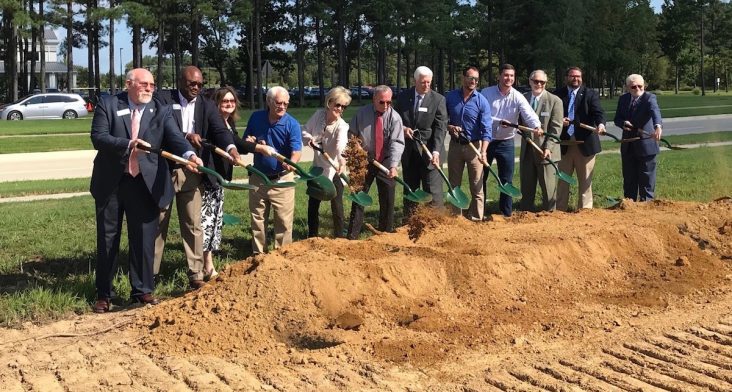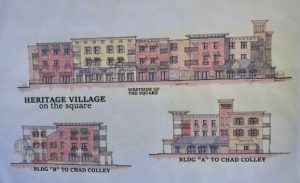ACHE breaks ground on $11 million residential, retail, entertainment development
by August 28, 2018 5:56 pm 3,631 views

Officials with the Arkansas Colleges of Health Education and other groups ceremonially break ground on the Heritage Village development project.
The Arkansas Colleges of Health Education (ACHE) has broken ground on an $11 million, 6.6-acre development across from the Arkansas College of Osteopathic Medicine (ARCOM). ACHE hosted a groundbreaking ceremony at the site on Tuesday (Aug. 28).
ACHE President and CEO Dr. Kyle Parker said the development known as Heritage Village will feature two residential/retail buildings comprising 86,000 square feet. Approximately 27,000 will be on the bottom floors of each building with the top two floors to be used as apartments. Parker told Talk Business & Politics after Tuesday’s event that about 80% “or 20,000-22,000 square feet” of the retail areas are spoken for.
The university will announce tenants all at once, “probably at the first of the year in January or February,” Parker said, adding that the development will be completed by July 2019.
“We already have most of the spaces spoken for. Of course, when you have 600 students and employees directly across the street in 2019 and over 1,000 by 2021, you can see why they’re in high demand.”
THE ENTERTAINMENT VENUE
A large green space will separate the two buildings. At the end of the stretch, facing ARCOM will be a 3,600 square-foot “entertainment pavilion.” It will be “pre-wired, pre-setup,” Parker said, with LED lights and built-in sound system, “so bands can come in, plug-and-play, and they don’t have to bring anything but a set of drums and their guitars. The mics are there. Everything is set up.”
ACHE is still weighing options for how to handle the leasing. Parker said the university “already had inquiries from people saying, ‘I just want to lease the pavilion period.’ And we’re going, ‘Well, does that make sense, or do we allow the restaurants that may be serving beer or what-have-you … get to come over and begin to switch that around?’ Pizza people sell beer. Sit-down restaurants may sell a beer. So, do you give them the ability to bring in entertainment, which may vary from establishment to establishment of what they want to play? Some want Rock and some want jazz and some want blues. We haven’t decided how to do that yet.”

“You can get some food there. We don’t have to worry about the food because you’re going to have restaurants all the way around us. But, do you sit there and lease that to a group that’s doing nothing but music all the time?”
Parker said a possible alternative would be to mix up the use of the pavilion so that it did some concerts and also some things with a more educational purpose.
“You start getting into the arts and the trails and the visual arts that we’re going to have all the way through here. Well, maybe then you want to have the Garden Club that’s here coming out of the park where the rose gardens are located — those kinds of meetings. That’s why we’re not sure yet how we want to do this.”
Regardless of what happens with the pavilion, it will be an indoor-outdoor venue with large fans and heaters to facilitate year-round use. It also will combine with the grassy knoll area in front to host a crowd of 6,000-7,000 people, Parker said, adding, “You can have a pretty good-sized group. I don’t expect Elton John to be here tomorrow, but you could have a very large group between those sitting on the grass, and those sitting inside the pavilion. It has an awful lot of versatility. We thought a long time on how to do this thing to make sure it’s not just for our students.”
THE RETAIL SIDE
Also Tuesday, Parker explained why there wouldn’t be any business names announced prior to the end of the year.
“We’re not doing that yet, but we’ve got several,” he explained. “What’s happened is, we have multiple people who want to go into restaurants. Friendly competition is nice if it’s the difference between a pizza parlor and a sit-down restaurant. That makes sense. We don’t want two pizza (parlors) sitting here or two sit-down restaurants. We’ve had inquiries, and we actually have letters of interest that have already been signed by people that comprise over 80% of the retail space, and we won’t open the doors until July of next year.”
Parker said Ghan & Cooper Commercial Properties are working out the complexities.
“We’re not going to rent something just to get rent. We’re not going to allow any risqué bars down here because it’s got to fit our mission. But there are some great surprises of things that are not found in Fort Smith that will be going in here.”
Heritage Village is classified as a planned zoning district (PZD), a first in the histories of Barling and Fort Smith. A PZD is a type of building development and also a regulatory process. As a building development, it’s a designed grouping of both varied and compatible land uses. These include housing, recreation, commercial centers, and industrial parks, all within one contained development or subdivision. Heritage Village was designed by Michael Watkins, whose previous work includes Seaside, Fla. The design work took approximately a year and a half to approve through the respective cities at an estimated cost to the University of $250,000.
